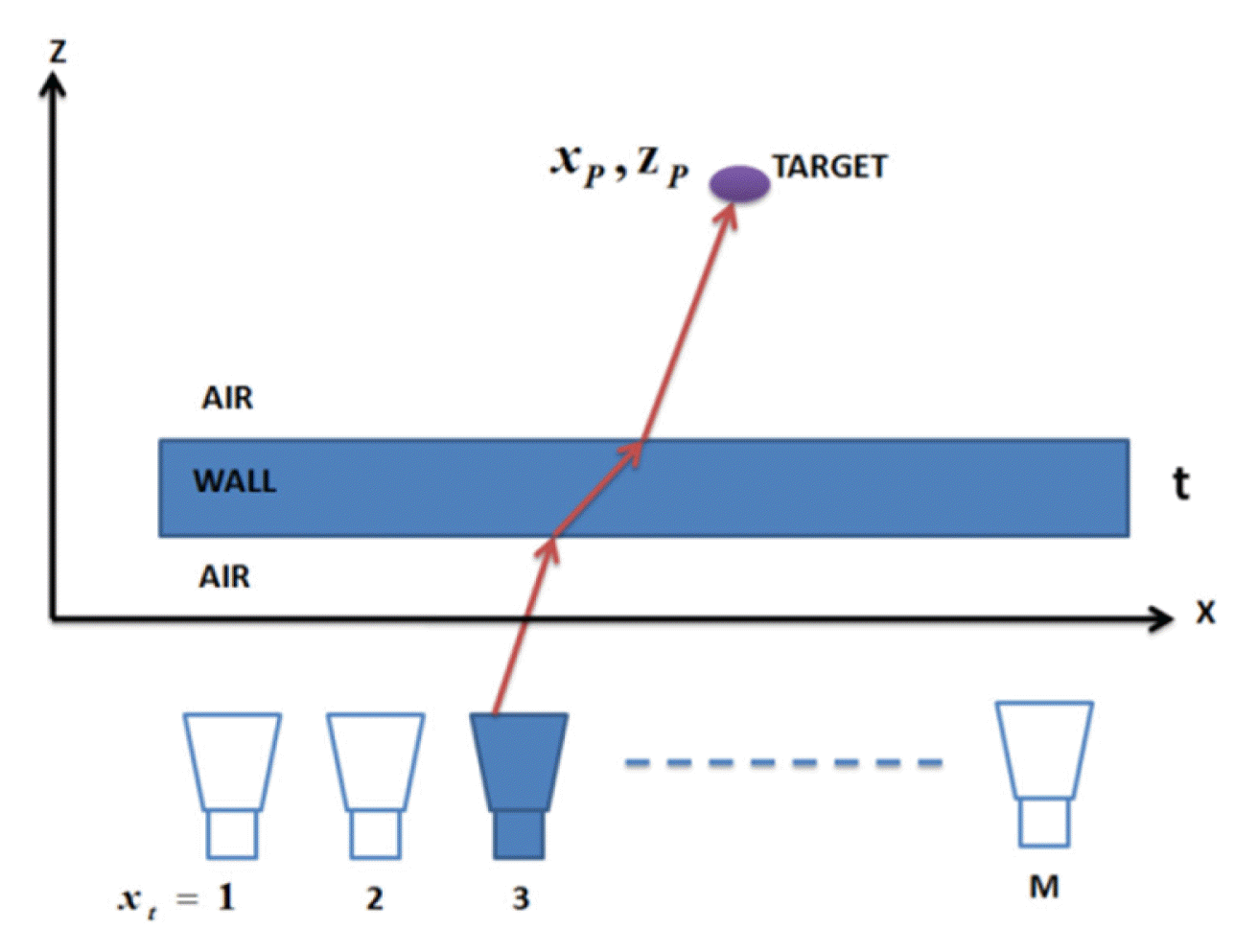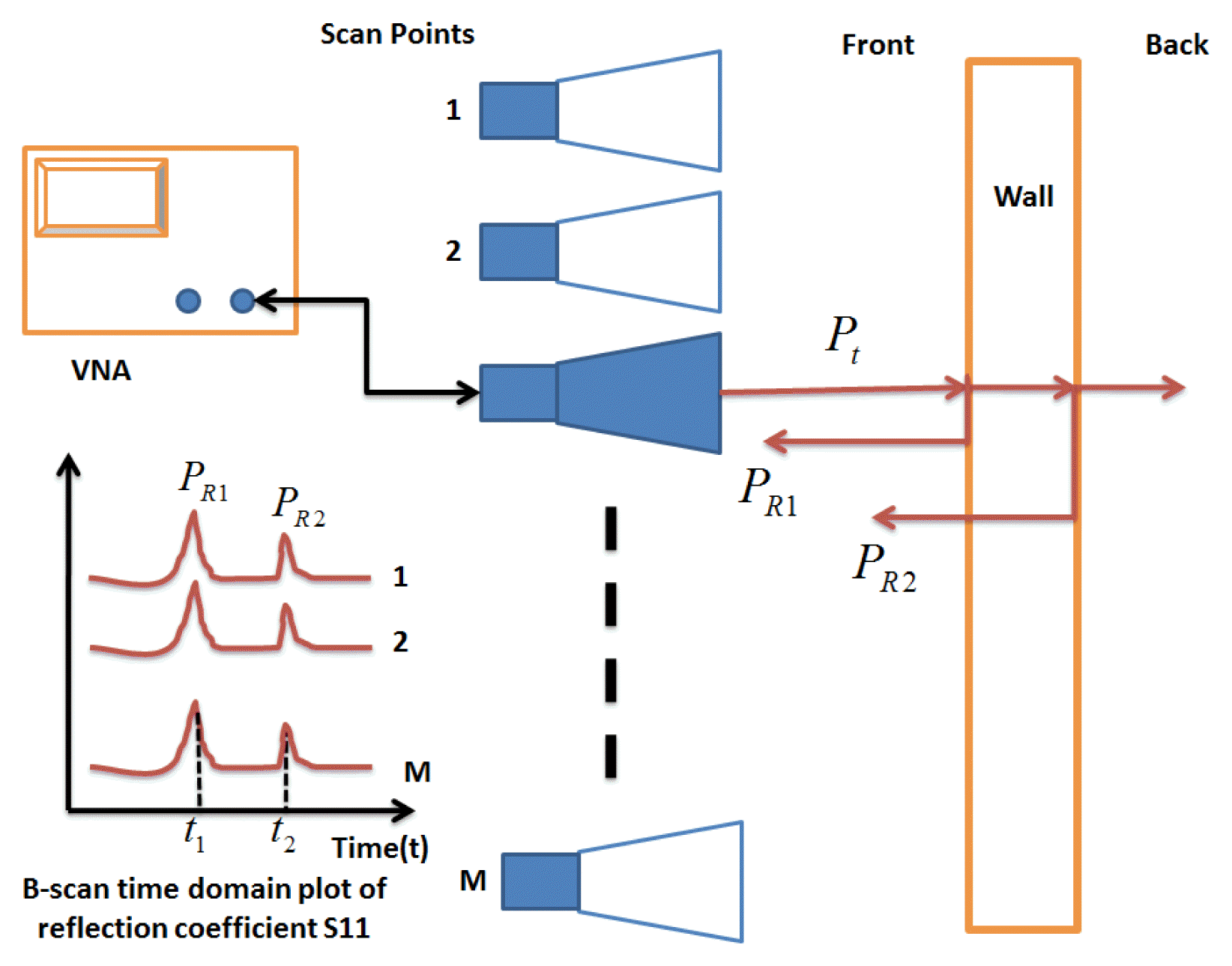 |
 |
- Search
| J. Electromagn. Eng. Sci > Volume 22(3); 2022 > Article |
|
Abstract
Through-the-wall radar images suffer from strong clutter due to the presence of dielectric walls and environmental noise. Several approaches have been explored to reduce clutter for detecting targets with similar dielectric constants. However, in real-time scenarios, targets may not have similar dielectric constants. Therefore, it is necessary to develop a technique for detecting contrast targetsŌĆöthat is, targets with different dielectric constants behind a wall in the same scene. This paper proposes a novel technique that combines time gating and Gaussian mixture model based low-rank approximation to detect contrast targets present in the same scene. The proposed method was compared to existing clutter reduction techniques in terms of target-to-clutter ratio (TCR). The experimental results showed that the proposed approach yielded highest TCR (130.1).
Through-the-wall radar imaging (TWRI) systems are an emerging technology that enables the detection of stationary or moving objects behind a wall from a position at a certain distance from the wall. TWRI systems use microwaves, which can easily propagate through walls to detect objects inside a building. They find various applications in many fields, such as the military, surveillance, indoor security, and search-and-rescue operations [1]. One of the several challenges is reducing the clutter present in the images produced by these systems to enhance their quality. Methods for reducing clutter in through-the-wall images include background subtraction, spatial filtering, image fusion, subspace projection, differential synthetic aperture radar (SAR), and entropy-based time gating [2ŌĆō13]. These techniques have limitations. Background subtraction requires a scene with no targets, which is impossible in real-time scenarios [7]. Spatial filtering works only for homogeneous walls at low operating frequencies. Image fusion requires multiple through-the-wall radar images of the same scene generated from distinct locations, which is impossible for moving targets [7]. Subspace projection methods, such as singular value decomposition (SVD), principal component analysis, factor analysis, and independent component analysis, have the disadvantage that the total number of targets must be known a priori [7].
Moreover, these techniques can detect only single targets or multiple targets with the similar dielectric constant in the same scene [14]. However, in real-time scenarios, targets may not have similar dielectric constants. Thus, it is necessary to develop a technique for detecting contrast targetsŌĆöthat is, targets with different dielectric constants behind a wall in the same scene.
Few studies have explored methods for detecting targets with different dielectric constants. Recently, low-rank approximation (LRA) was developed to attenuate random noise in the received signal [14]. This paper proposes a novel technique that combines time gating and Gaussian mixture modelŌĆōbased LRA for contrast target detectionŌĆöthat is, the detection of targets with low and high dielectric constants behind a wall in the same scene. The proposed method works well with heavily cluttered through-the-wall images and enhances their quality.
The rest of this paper is structured as follows. Chapter II describes the through-the-wall imaging system model. Chapter III presents the proposed method for contrast target detection. Chapter IV reports and discusses the experimental results. Chapter V presents the conclusions.
The imaging setup shown in Fig. 1 is placed at a certain distance from the wall, and data are acquired at M scan points along a horizontal direction parallel to the wall. The scan points represent the positions of the antenna of the stepped frequency continuous wave (SFCW) radar. The scene being imaged is situated behind the wall along the positive z-axis. At each scan point, the SFCW radar transmits and receives the signal scattered from the target. It transmits a wideband signal in step frequency mode, in which it sweeps through the allocated signal bandwidth via a series of narrowband signals of uniformly spaced center frequencies. The SFCW radar measures and records the magnitude and phase of the received signal scattered from the target for various frequencies at each spatial point. The scene is divided into pixels downrange and cross-range, represented by the z and x coordinates, respectively. The magnitude and phase of the scattered field from a P-point target located in position xpi,,zpi behind the wall for various frequencies at different scan points are calculated as
where fk is the frequency point, Žäpi is the propagation delay between the radar at mth scan point and the pixel position, and a(xpi,,zpi) is the target.
For each pixel, the corresponding propagation delay is calculated as [15]
where c is the speed of signal propagation in the air, v is the speed of the signal propagating through the wall, and lairtowall, lwall, and lwalltoair represent the signalŌĆÖs distance from the radar when in front of the wall, inside the wall, and behind the wall at mth scan point to the pixel at location xpi,,zpi. The details of expression lairtowall, lwall, and lwalltoair are provided by Ahmad et al. [15].
After applying delays to the signal received in the frequency domain at each radar location to synchronize the signals arriving at each radar location and then summing the delayed signals, the value of a pixel at location xpi,,zpi is calculated as [6]
Similarly, for the P-point scatterer in positions xpi,,zpi, the value of each pixel at different P positions xpi,,zpi is calculated as [6]
The proposed method for contrast target detection consists of three stages. In the first stage, clutter due to strong wall reflections is reduced using time gating based on the wall propagation time. In the second stage, delay-and-sum beamforming are applied to time-gated frequency domain data to obtain a focused image of the target. In the third stage, a Guassian mixture for LRA is introduced to detect targets with low dielectric constants and suppress noise.
Frequency domain data collected along M horizontal scan points are inverse Fourier transformed to obtain time domain data. The time domain data at mth observation position can be written as [5]
where t ranges from 0 to (NŌĆō1) = signal bandwidth (BW) at ╬öt step intervals of 1/BW.
Upon discretizing time, S denotes the M X N matrix of the time domain data at M horizontal scan points, S = [S (m, n)], m = 1, 2, ŌĆ”, MŌĆō1, and n = 1, 2, ŌĆ”, N. M and N are the numbers of antenna positions and time samples, respectively.
To reduce wall clutter, the time domain data S (m, n) are time-gated based on the wall propagation time (W). The threshold is set to
where W is given by W=(dŌłÜ╬Ą + zoff), n is the time sample, zoff is the standoff distance, and c is the speed of light. The time trace after incorporating the threshold is calculated as
To compute the wall propagation time, the wallŌĆÖs dielectric constant and thickness must be known a priori to compensate for the wallŌĆÖs effects. The effective dielectric constant and thickness were estimated by exploiting the first two dominant echoes originating from the front and rear sides of a real building wall. Such walls are generally made of bricks and covered in a fine layer of plaster. Since the size of the inhomogeneities is smaller than the range resolution, the wall can be modeled as a homogeneous layer characterized by effective permittivity [16].
The signal transmitted from the antenna at a certain scan point has power Pt. The signal propagates toward the wall and is incident on the front side of the wall, as shown in Fig. 2. A signal with a certain portion of power is reflected, and a signal with a certain portion of power propagates through the wall.
The received signal reflected from the front side of the wall has power PR1 and appears as a peak at time point t1. The received signal reflected from the rear side of the wall has power PR2 and appears as a peak at time point t2. PR1 can be written as [17, 18]
where PL1 is the total loss, which includes the cable loss as the signal propagates from vector network analyzer VNA to the antenna and the path loss between the antenna and the front side of the wall, and |╬ō| is the magnitude of the reflection coefficient at the interface of the front side. PR2 can be calculated as [17, 18]
where PL2 is the total loss, which includes the cable loss as the signal propagates from VNA to the antenna and the path loss between the antenna and the rear side of the wall, and |╬ō| is the magnitude of the reflection coefficient at the interface of the rear side.
Considering the cable and path losses to be the same, a mathematical relation between PR1, PR2, and the reflection coefficient can be written as
Where |╬ō| represents the reflection coefficients at the interfaces of the front and rear surfaces of the wall, ╬▒ is the wall attenuation constant, and d is the wall thickness, which is given by
where Žā is the electrical conductivity of the wall, ╬Ę is 377 ╬®, and c is the speed of light in free space.
Substituting Eqs. (11), (12), and (13) for (10), we can express Eq. (10) in terms of other variables as follows:
The wallŌĆÖs dielectric constant and thickness can be obtained by exploiting PR1 at time point t1, PR2 at time point t2 from time domain plot, and time delay ╬öŽä=t2-t1. Thus, the dielectric constant and electrical conductivity of the wall can be estimated by formulating a proper fitness function and minimizing it using an efficient searching technique, a genetic algorithm, which can be written as
Once the wallŌĆÖs dielectric constant has been obtained, its thickness d can be computed using Eq. (13). To obtain PR1 and PR2 at time points t1 and t2 at all scan points, first, S(m, n) are added up in the time domain.
Next, the maximum value of Sum(n) is obtained, and the threshold is set as
where ╬▒ < 1 is the tolerance band. Then, based on Eq. (17), the peak PR1 and PR2 values and corresponding time points t1 and t2 can be obtained for all M scan points as follows:
After the time gating process, the time domain data ST(m, n) are Fourier-transformed and further processed by applying delay-and-sum beamforming using Eq. (4) to produce a focused image of the target. Although the echo of high dielectric constant target is strong, the echo of targets with low dielectric constants is comparable to noise. Therefore, LRA is introduced to reduce noise based on the Gaussian mixture model to detect a target with a low dielectric constant along with a target with a high dielectric constant. After applying SVD, the beamformed image matrix I can be expressed as [14]
where U and V are M X M and N X N unitary matrices, S = diag(╬╗1, ╬╗2, ..., ╬╗ r), and ╬╗ is a singular value in the order of ╬╗1 > ╬╗2 >ŌĆ”ŌĆ”ŌĆ”. ╬╗r > 0. U and V are eigen vectors of I.
It was observed that the boundaries of the singular values corresponding to the target and noise were not clearly defined. Hence, it is not feasible to exploit singular values accurately corresponding to the target. Thus, a Gaussian mixture model is used to segregate the singular values corresponding to the target and noise.
After normalizing ╬╗(r), the singular values are modeled as a mixture of Gaussian distributions. The Gaussian components in the mixture are composed of target and noise components, and the overlapping boundaries of the singular values corresponding to the target and noise are separated using clustering based on maximum a posteriori. The singular values are modeled using an expectationŌĆōmaximization algorithm to obtain the parameters of the Gaussian mixture, which is given by [19]
Where ╬╝K is the mean of the k-th Gaussian component, ŽāK2 is the variance of the k-th Gaussian component, K is the number of Gaussian components, K = 1 represents the target component, K = 2 represents the noise component, and G(r) is the Gaussian component given by
To segment the singular values corresponding to the target from those corresponding to noise, clustering that assigns each data point to one of the two mixture components in the Gaussian mixture model based on posterior probability is performed as
The center of each cluster is the mean of the corresponding mixture component. After obtaining n singular values corresponding to the target from matrix S and setting other values to zero such that S̄ =S (1 : n, 1 : n), the LRA matrix is computed as
To evaluate the image enhancement capability of the proposed method, four TWRI scene was simulated using two targets, one with a low dielectric constant (wood) and one with a high dielectric constant (metal), behind a wall (Table 1). Photographs of the targets and their measured radar cross-section values are shown in Table 2. An experiment was performed using SFCW radar. Scattering parameter S11 was measured for 201 frequency points in the frequency range of 3.5ŌĆō5.5 GHz at 27 scan points along the horizontal direction. The imaging setup was placed at a distance of 2.2 m from the front side of the wall. Fig. 3(a) shows the raw B-scan image. Fig. 3(b) shows the image of the B-scan obtained using Eq. (18) to extract the peak PR1 and PR2 values from the front and rear sides of the wall at time points t1 and t2, respectively. The wallŌĆÖs thickness and effective permittivity after incorporating the peak PR1 and PR2 values and time delay Žä were computed using Eqs. (13) and (15).
The wallŌĆÖs thickness and dielectric constant were found to be 14.4 cm and 6.4, respectively. To validate the results, the wallŌĆÖs effective permittivity was computed using a wall insertion transfer function in a manner similar to that described by Chandra et al. [20]. The wallŌĆÖs effective permittivity obtained was 6.5 and actual thickness of wall was 14.5cm. The wallŌĆÖs effective permittivity estimated using the frequency domain method was in good agreement with that obtained using the method proposed by Chandra et al. [20].
After estimating the wall parameters, the frequency domain data were processed to enhance the image using the proposed method. The image was then assessed in terms of target-to-clutter ratio (TCR), calculated as [6]
where At is the target area, Ac is the clutter area, Nt is the number of pixels in the target area, and Nc is the number of pixels in the clutter area.
Fig. 4 shows the through-the-wall radar image of the scene behind the wall after applying a delay-and-sum beamforming algorithm directly to the frequency domain dataŌĆöthat is, scattering parameter S11 without clutter reduction and with clutter reduction using different techniques. The proposed method produced an enhanced image and was capable of detecting the target with the low dielectric constant (wood) along with the target with the high dielectric constant (metal) in the same scene.
Table 3 presents a comparison of the proposed method with other clutter reduction techniques in terms of TCR for the images shown in Fig. 4. The proposed method obtained the highest TCR (130.1).
Fig. 5 shows through-the-wall radar images with delay-and-sum beamforming applied using the proposed method for Scenes 2, 3, and 4. The proposed method enhanced the quality of the images, demonstrating its effectiveness with different target types and arrangements.
To determine the margin of error needed for this technique to work, the TCR of the Scene 1 image obtained using the proposed method was calculated with varying wall dielectric constant and thickness values by 5%. The obtained TCR values are shown in Table 4 and 5. The TCR decreased as the dielectric constant changed by 20% and as the thickness changed by 10%. Thus, an estimation accuracy of more than 20% for the dielectric constant and more than 10% for thickness is sufficient for this method to work.
This study proposes a novel method for contrast target detection. The inherent problem of strong clutter due to the wall and its residual due to the interactions between the wall is addressed using time gating based on the wall propagation time, and noise is reduced using LRA based on a Gaussian mixture model.
The proposed method was validated using through-the-wall images generated using SFCW radar. The experimental results showed that this method can detect targets with a low dielectric constant in the presence of targets with a high dielectric constant in heavily cluttered through-the-wall images of the same scene with satisfactory accuracy.
The proposed technique was also compared to existing clutter reduction techniques, such as entropy-based time gating, SVD, average trace subtraction, differential SAR approach, robust PCA, and entropy-based low-rank approximation. The proposed method showed highest TCR (130.1).
An estimation accuracy of more than 20% for the wallŌĆÖs dielectric constant and more than 10% for its thickness is sufficient for the proposed method to work. This method is quite effective in reducing clutter due to inhomogeneous walls, provided that inhomogeneity is smaller than the range resolution.
Fig.┬Ā3
(a) Raw B-scan image of Scene 1 and (b) B-scan image of Scene 1 after extracting the wall reflections.
Note: The values shown in the color bars represent power.

Fig.┬Ā4
Delay-and-sum-beamformed images of Scene 1 (a) without clutter reduction and with clutter reduction as described in (b) Solimeme and Cuccaro [10], (c) Yoon and Amin [3], (d) Bivalkar et al.[14], (e) Dehmollaiah et al. [9], (f) Liu et al. [8], and (g) Tivive et al. [6], and (h) using the method proposed in this study.
Note: The values shown in the color represent the magnitude of the pixel values.

Fig.┬Ā5
Delay-and-sum-beamformed images (a) without clutter reduction and (b) with clutter reduction for Scene 2, (c) without clutter reduction and (d) with clutter reduction for Scene 3, and (e) without clutter reduction and (f) with clutter reduction for Scene 4.
Note: The values shown in the color represent the magnitude of the pixel values.
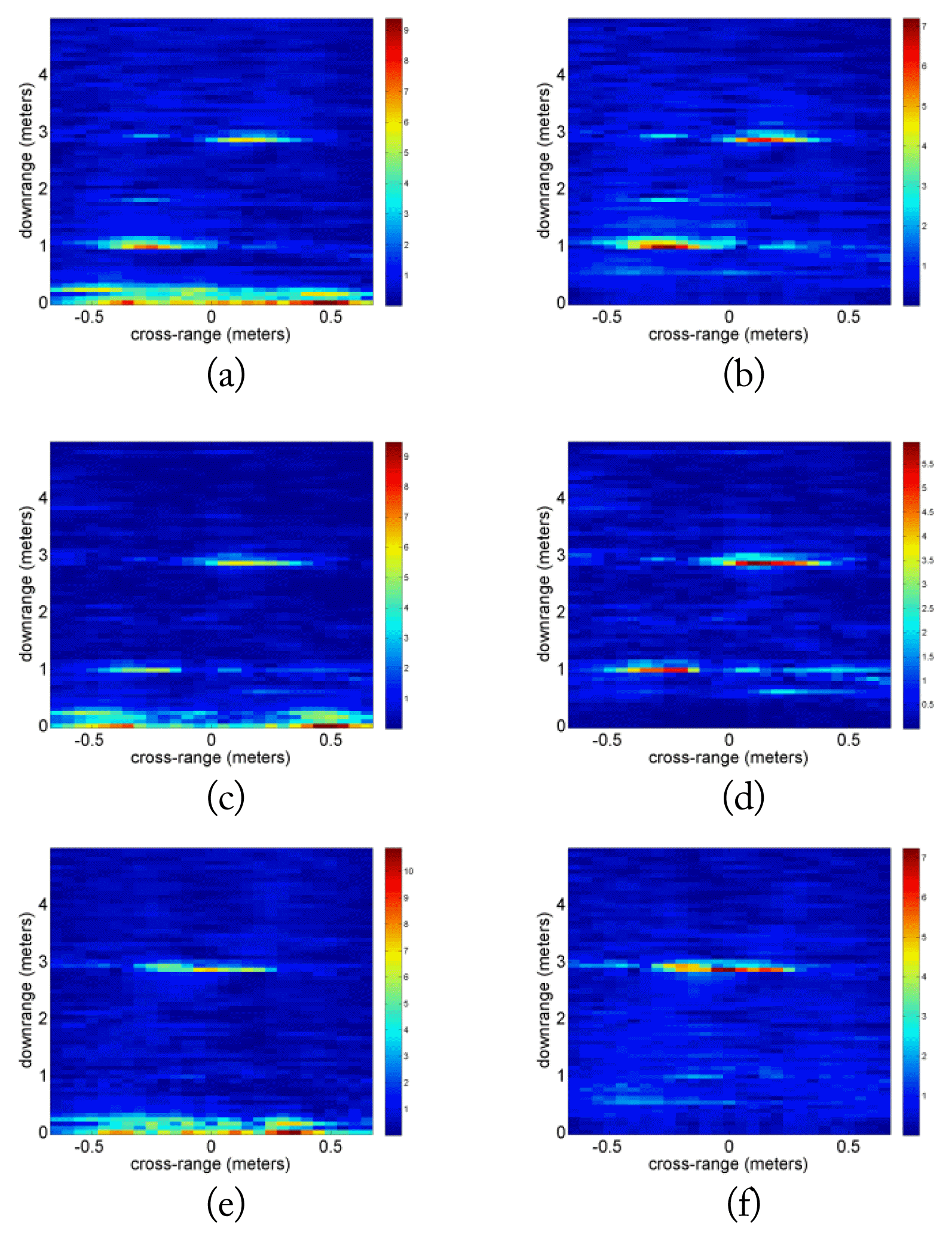
Table┬Ā1
Details of TWRI scenes with arrangement of targets
| Scene | Number of targets | Target ID | Distance from the wall (m) |
|---|---|---|---|
| 1 | 2 | T1 | 0.6 |
| T2 | 2.8 | ||
| 2 | 2 | T1 | 1 |
| T2 | 2.8 | ||
| 3 | 2 | T2 | 1 |
| T1 | 2.8 | ||
| 4 | 1 | T2 | 2.8 |
Table┬Ā2
Photographs of the targets and their radar cross-section values
| Target image | RCS value (dBsm) [21] |
|---|---|
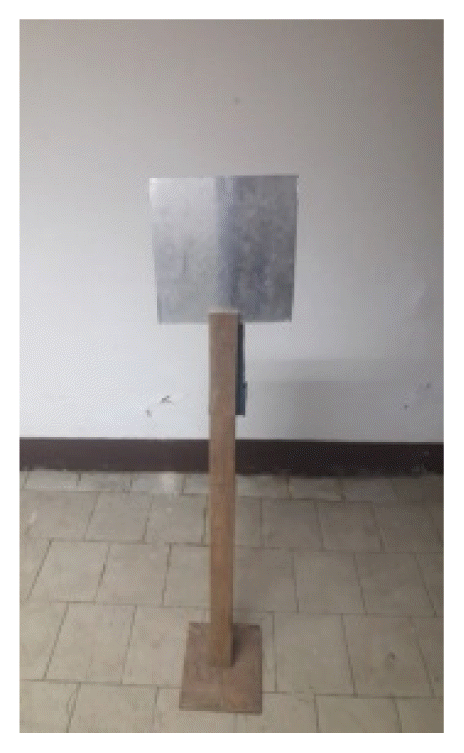 Target ID: T1 |
7.4 |
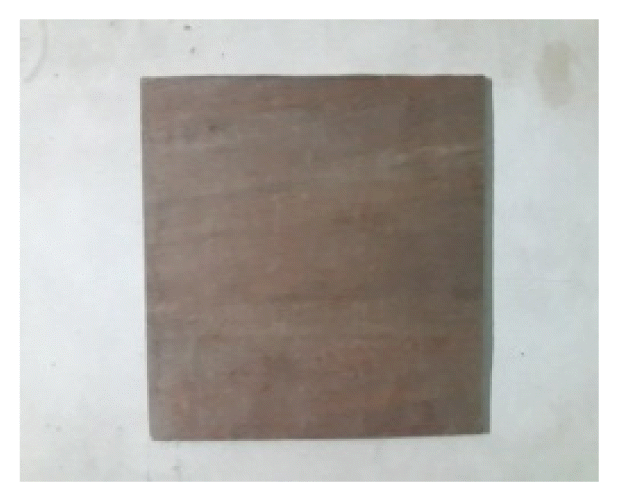 Target ID: T2 |
ŌłÆ6.8 |
Table┬Ā3
Target-to-clutter ratios obtained using different clutter reduction methods
| Method | TCR |
|---|---|
| Entropy-based time gating [10] | 19.3326 |
| Average trace subtraction [3] | 26.0593 |
| Entropy-based low-rank approximation [14] | 37.6390 |
| Differential SAR [9] | 3.3156 |
| Robust PCA [8] | 33.4671 |
| SVD with AIC [6] | 9.9430 |
| Proposed method | 130.1 |
References
1. EJ Baranoski, "Through-wall imaging: historical perspective and future directions," Journal of the Franklin Institute, vol. 345, no. 6, pp. 556ŌĆō569, 2008.

2. J Moulton, S Kassam, F Ahmad, M Amin, and K Yemelyanov, "Target and change detection in synthetic aperture radar sensing of urban structures," In: 2008 IEEE Radar Conference; Rome. pp 1ŌĆō6, 2008.

3. YS Yoon and MG Amin, "Spatial filtering for wallclutter mitigation in through-the-wall radar imaging," IEEE Transactions on Geoscience and Remote Sensing, vol. 47, no. 9, pp. 3192ŌĆō3208, 2009.

4. CH Seng, A Bouzerdoum, FHC Tivive, and MG Amin, "Fuzzy logic-based image fusion for multi-view through-the-wall radar," In: 2010 International Conference on Digital Image Computing: Techniques and Applications; Sydney. pp 423ŌĆō428, 2010.

5. AN Gaikwad, D Singh, and MJ Nigam, "Application of clutter reduction techniques for detection of metallic and low dielectric target behind the brick wall by stepped frequency continuous wave radar in ultra-wideband range," IET Radar, Sonar & Navigation, vol. 5, no. 4, pp. 416ŌĆō425, 2011.

6. FHC Tivive, A Bouzerdoum, and MG Amin, "A subspace projection approach for wall clutter mitigation in through-the-wall radar imaging," IEEE Transactions on Geoscience and Remote Sensing, vol. 53, no. 4, pp. 2108ŌĆō2122, 2014.

7. Y Lim and S Nam, "Target-to-clutter ratio enhancement of images in through-the-wall radar using a radiation pattern-based delayed-sum algorithm," Journal of Electromagnetic Engineering and Science, vol. 14, no. 4, pp. 405ŌĆō410, 2014.

8. L Liu, Q Chen, Y Han, H Xu, J Li, and B Wang, "Improved clutter removal by robust principal component analysis for chaos through-wall imaging radar," Electronics, vol. 9, no. 1, pp. 252020.

9. M Dehmollaiah, M Theil, and K Sarabandi, "Through wall imaging using differential SAR," IEEE Transactions on Geoscience and Remote Sensing, vol. 47, no. 5, pp. 1286ŌĆō1296, 2009.
10. R Solimene and A Cuccaro, "Front wall clutter rejection methods in TWI, IEEE," Geoscience and Remote Sensing Letters, vol. 11, no. 6, pp. 1158ŌĆō1162, 2013.
11. Y Zhang and T Xia, "In-wall clutter suppression based on low-rank and sparse representation for through-the-wall radar," IEEE Geoscience and Remote Sensing Letters, vol. 13, no. 5, pp. 671ŌĆō675, 2016.

12. AP Singh, S Dwivedi, and PK Jain, "A novel application of artificial neural network for recognition of target behind the wall," Microwave and Optical Technology Letters, vol. 62, no. 1, pp. 152ŌĆō167, 2020.


13. D Kim, B Kim, and S Nam, "A dual-band through-the-wall imaging radar receiver using a reconfigurable high-pass filter," Journal of Electromagnetic Engineering and Science, vol. 16, no. 3, pp. 164ŌĆō168, 2016.

14. M Bivalkar, D Singh, and H Kobayashi, "Entropy-based low-rank approximation for contrast dielectric target detection with through wall imaging system," Electronics, vol. 8, no. 6, pp. 6342019.

15. F Ahmad, Y Zhang, and MG Amin, "Three-dimensional wideband beamforming for imaging through a single wall," IEEE Geoscience and Remote Sensing Letters, vol. 5, no. 2, pp. 176ŌĆō179, 2008.

16. P Protiva, J Mrkvica, and J Mach├Īc, "Estimation of wall parameters from time-delay-only through-wall radar measurements," IEEE Transactions on Antennas and Propagation, vol. 59, no. 11, pp. 4268ŌĆō4278, 2011.

17. V Singh and S Bhattacharyya, "Retrieval of electrical and physical properties of dielectric samples using time-domain multiple reflection method," IET Microwaves, Antennas & Propagation, vol. 14, no. 8, pp. 701ŌĆō706, 2019.


18. Z Akhter and MJ Akhtar, "Time domain microwave technique for dielectric imaging of multi-layered media," Journal of Electromagnetic Waves and Applications, vol. 29, no. 3, pp. 386ŌĆō401, 2015.

19. Y Bazi, L Bruzzone, and F Melgani, "Image thresholding based on the EM algorithm and the generalized Gaussian distribution," Pattern Recognition, vol. 40, no. 2, pp. 619ŌĆō634, 2007.

Biography

Akhilendra Pratap Singh received a Ph.D. degree in electronics engineering from the Indian Institute of Technology (Banaras Hindu University), Varanasi, India, and an M.Tech degree in digital communications from the ABV Indian Institute of Information Technology and Management, Gwalior, M.P., India. He is currently an assistant professor at the School of Engineering and Technology of the Maharishi University of Information Technology, Lucknow, U.P., India. He works in the area of through-the-wall imaging radar.
Biography

Smrity Dwivedi received a Ph.D. degree in electronics engineering from the Indian Institute of Technology (Banaras Hindu University), Varanasi, India. She is currently an assistant professor in the Department of Electronics of the Indian Institute of Technology (Banaras Hindu University). She has more than 20 research papers to her credit, published in various international journals. Her research interests include microwave imaging and high-power microwave devices and circuits.
Biography
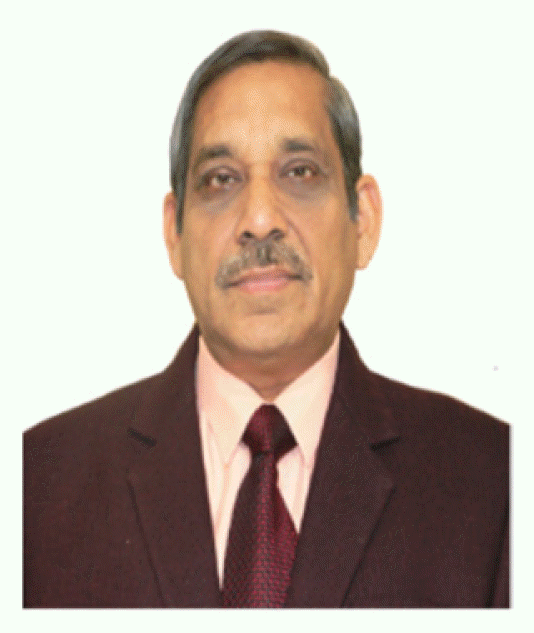
Pradip Kumar Jain received a Ph.D. in electronics engineering from the Institute of Technology, Banaras Hindu University (now IIT [BHU]), Varanasi, India. He is currently Director of the National Institute of Technology, Patna, India. He has more than 100 research papers to his credit, published in various international journals. He has vast R&D experience in the areas of RF and communications engineering, microwave/millimeter wave devices and circuits, and high-power microwave electron beam devices and has actively engaged in collaborative research at national laboratories.
- TOOLS
- Related articles in JEES




